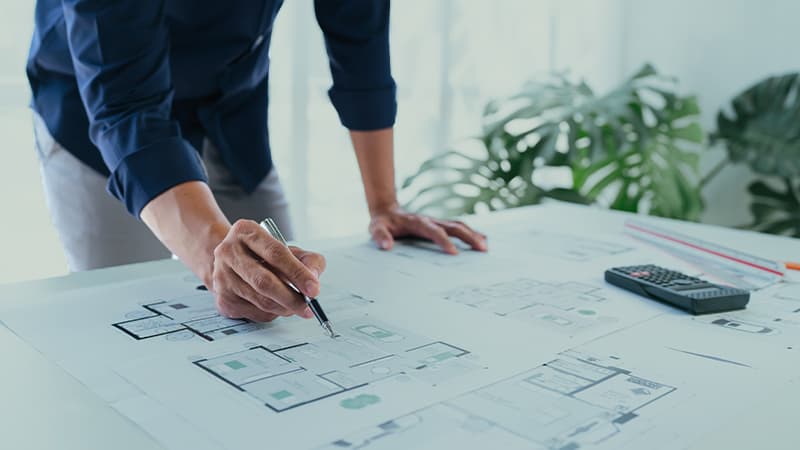Recognizing the Diverse Job Paths Available for Aspiring Architect
As a hopeful Architect, you have a world of job paths waiting for you. Each path provides one-of-a-kind obstacles and possibilities to apply your creativity and technological knowledge. Whether you're attracted to conventional style or the nuances of lasting style, there's a specific niche that aligns with your interests. Recognizing these diverse choices can form your professional journey, yet which instructions will you select to check out initially?
Traditional Style: Creating Structures and structures
Standard architecture concentrates on developing structures and structures that mix functionality with aesthetic appeal. As you explore this area, you'll appreciate the detailed balance in between kind and objective. You'll discover to draw ideas from historic designs, integrating aspects like symmetry, materials, and workmanship. Your layouts can mirror social heritage, showcasing regional practices while fulfilling contemporary requirements.
You'll create skills in composing, model-making, and site evaluation, allowing you to picture and interact your ideas effectively. Involving with clients, you'll require to understand their vision and equate it right into feasible layouts.
Additionally, building codes and sustainability techniques are vital in your job, guaranteeing your frameworks are eco friendly and safe. As you grow in your job, you'll find opportunities in household, commercial, and even remediation projects, each offering unique difficulties. Embracing standard style leads the way for a fulfilling occupation that admires the past while forming the future.
Urban Preparation: Forming Neighborhoods and Public Spaces
As an aspiring Architect, you can play an essential duty as a metropolitan organizer, transforming how neighborhoods function and engage. By utilizing neighborhood engagement methods, you'll assure that citizens have a voice in shaping their environment. And also, integrating sustainable style concepts will assist produce areas that not just satisfy today's demands yet also protect the future.
Function of Urban Planners
While numerous might think of designers as the single visionaries behind buildings, urban planners play a crucial duty in shaping the more comprehensive landscape of communities and public spaces. They analyze land usage, zoning legislations, and area requires to create sustainable settings that improve high quality of life. By collaborating with numerous stakeholders, you'll assist make parks, transportation systems, and suburbs that promote social communication and availability. Urban organizers likewise concentrate on environmental considerations, ensuring that advancements integrate eco-friendly spaces and support biodiversity. Your expertise in spatial layout and area dynamics enables you to picture future growth while protecting cultural heritage. In this crucial function, you'll directly influence just how people experience their surroundings, making every project an opportunity for positive change.
Neighborhood Interaction Strategies
Reliable neighborhood interaction approaches are important for metropolitan planners to assure that the voices of citizens are heard and valued in the preparation procedure. To promote purposeful discussion, you ought to prioritize open forums and workshops where neighborhood members can reveal their ideas and problems. Usage surveys and social media sites to reach a more comprehensive target market, guaranteeing varied viewpoints are included. Teaming up with local organizations can improve trust fund and help with deeper connections. It's important to give clear info about suggested jobs and decision-making procedures, enabling residents to feel enlightened and empowered. By actively listening and integrating comments, you'll develop spaces that show the community's needs, ultimately resulting in more successful and sustainable metropolitan environments. Accept openness and continual discussion for long lasting effect.
Lasting Layout Principles
When creating city rooms, integrating lasting style principles is critical for developing settings that prosper both ecologically and socially. Take into consideration incorporating environment-friendly rooms, like parks and yards, to improve biodiversity and enhance air quality.
Designing with water preservation in mind is additionally key-- consider rain yards and absorptive surface areas to handle stormwater. Including area members throughout the planning procedure assurances that the rooms you produce satisfy their requirements and encourage social interaction. By embracing these concepts, you'll add to vibrant, sustainable city landscapes that profit everyone.

Landscape Style: Creating Lasting Outdoor Settings
As you discover landscape design, you'll discover crucial layout concepts that create attractive and functional outdoor areas. Sustainable techniques play a crucial function in making sure these environments grow while reducing environmental impact. And also, you'll locate a variety of career possibilities that permit you to make a real difference in just how people connect with nature.
Layout Concepts in Landscape
Understanding design concepts in landscape architecture is necessary for developing lasting outdoor settings that harmonize with nature. You'll require to ponder aspects like scale, proportion, and balance to guarantee your styles feel natural and welcoming. Additionally, pay attention to seasonal adjustments, designing with products that match the environments year-round.
Sustainable Practices Introduction
Lasting practices in landscape architecture not only focus on aesthetic appeals yet also prioritize environmental health and wellness and resource conservation. You can create areas that advertise soil health and wellness, such as using organic products and practicing permaculture principles. Inevitably, these practices assure your designs profit both people and the setting for years to come.
Job Opportunities Exploration
With a strong foundation in sustainable practices, landscape design provides a selection of career courses that enable you to make a significant impact on the environment. Urban coordinators often work together with landscape designers to produce environment-friendly areas in metropolitan settings, enhancing city livability. If you're enthusiastic regarding education, consider becoming a landscape style educator, motivating future generations.
Lasting Style: Concentrating On Eco-Friendly Practices
As you discover your occupation in architecture, accepting environmentally friendly methods can establish you apart in a competitive area. Sustainable design concentrates on producing buildings that decrease ecological impact while boosting occupant well-being. By incorporating eco-friendly products, energy-efficient systems, and lasting structure methods, you'll add to a greener future.
Beginning by acquiring knowledge of environment-friendly certifications like LEED or BREEAM, which can bolster your credentials. Consider exactly how natural light, ventilation, and thermal effectiveness can enhance layout. Team up with designers and ecological experts to introduce solutions that reduce waste and preserve resources.
Don't fail to remember the value of area participation-- appealing neighborhood stakeholders can inspire layouts that balance with the setting. As customers increasingly prioritize sustainability, your proficiency in environment-friendly methods will not only bring visit the website in tasks yet likewise meet your enthusiasm for responsible design. Accept this critical element of the occupation, and enjoy your profession prosper.
Historical Conservation: Securing and Bring Back Social Heritage
While you begin on your building trip, think about the important role of historic conservation in keeping our social heritage. This field focuses on the protection and repair of considerable structures, websites, and frameworks that tell the tales of our past. By taking part in historic preservation, you'll assist safeguard the architectural heritage that forms neighborhood identification.
As a historical preservation Architect, you'll evaluate historic importance and evaluate the problem of structures. You'll work closely with chroniclers and guardians to ensure genuine reconstruction strategies are employed. This career path permits you to mix creativity with study, enabling you to design solutions that appreciate initial products and workmanship.
Your work not only adds to sustainability by recycling existing structures however also promotes a feeling of pride within communities. Embracing this course will help you end up being a guardian of history, maintaining the tales and aesthetic appeals that enrich our lives.
Inside Design: Enhancing Indoor Spaces
Historic preservation and indoor style both share a commitment to enhancing the built atmosphere, yet they concentrate on different aspects. While historical preservation emphasizes keeping a structure's social and historical worth, indoor design absolutely nos in on enhancing indoor rooms for functionality and aesthetic appeals.
As a hopeful Architect, you'll locate that interior architecture permits you to mix creativity with technological skills. You'll make rooms that not just look good yet also advertise browse around here convenience and efficiency. This area involves recognizing exactly how light, color, and materials interact within a space, impacting mood and use.
You'll work on various tasks, from domestic homes to commercial offices, making sure that each setting meets the needs of its residents. By prioritizing individual experience, you can change interiors right into inspiring and practical rooms, making a substantial influence on just how people connect with their surroundings. Accept the possibility to boost interior settings and shape the means people live and function.
Industrial Layout: Combining Performance With Appearances
Commercial design plays a crucial duty in producing items that flawlessly mix looks with capability, ensuring that what you utilize day-to-day is not just aesthetically appealing however also functional. As an ambitious Architect, you could immerse yourself in this area, concentrating on developing whatever from furnishings to consumer electronics. Your work includes understanding individual requirements, products, and making processes, permitting you to produce ingenious options that boost everyday experiences.
In commercial layout, you'll usually collaborate with engineers, suppliers, the original source and online marketers, guaranteeing that your layouts are not only gorgeous but additionally viable. This job course uses a vibrant setting where creativity fulfills practicality, making it a satisfying option for engineers interested in forming the products of tomorrow.
Frequently Asked Questions
What Educational Certifications Do I Need to Come To Be a Designer?
To end up being an engineer, you'll need a specialist degree in architecture, generally a Bachelor's or Master's. Furthermore, you'll need to complete an internship and pass the Architect Registration Assessment to practice legally.
Are There Certification Demands for Different Building Occupation Paths?
Yes, there're certification requirements for numerous architectural paths. Architect. You'll need to pass tests, complete internships, and often go after specialized training, relying on your picked focus, like landscape architecture, urban style, or historical preservation
What Software Skills Are Vital for Designers Today?

Exactly How Can I Gain Practical Experience While Studying Style?
You can acquire sensible experience by interning at architectural companies, joining design competitors, offering for neighborhood tasks, or working together with classmates on real-world assignments. These possibilities improve your abilities and develop useful links in the market.
What Task Opportunities Exist Outside Conventional Design Firms?
You can check out various task chances outside conventional design companies, like metropolitan planning, interior decoration, landscape style, construction monitoring, realty development, and even functions in sustainability consulting. Each deals distinct challenges and rewards.
Whether you're attracted to traditional architecture or the subtleties of sustainable design, there's a specific niche that aligns with your interests.When making metropolitan spaces, including sustainable design principles is critical for producing environments that flourish both ecologically and socially.As you discover landscape design, you'll discover important design concepts that create beautiful and practical outdoor rooms.Recognizing style concepts in landscape design is important for developing sustainable outside atmospheres that balance with nature.In commercial layout, you'll frequently team up with manufacturers, designers, and marketers, ensuring that your layouts are not only beautiful yet also possible.
Comments on “Architect Portfolio Tips for Making an Impact in the Industry”